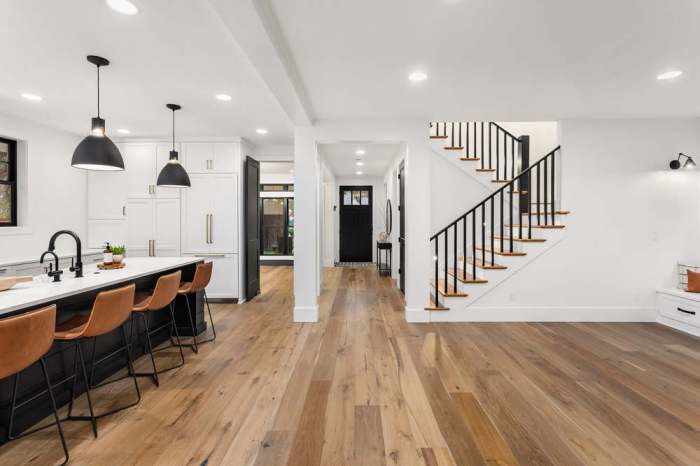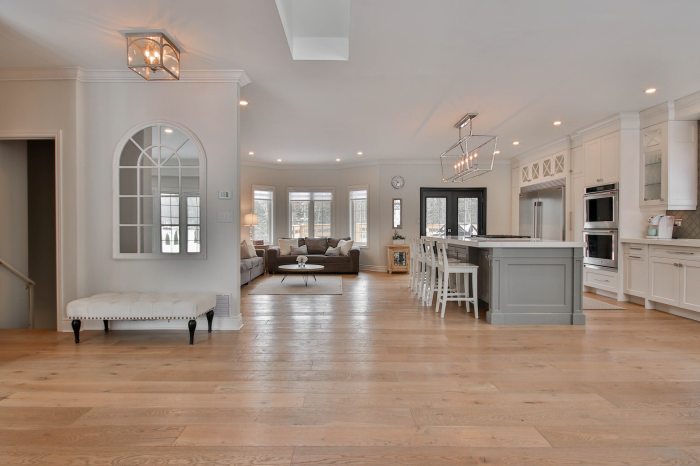The Ultimate Guide to Choosing the Best Flooring for Home Remodel
Embark on a journey to discover the best flooring options for your home remodel. From hardwood to vinyl, we explore the pros and cons of each material, helping you make an informed decision that suits your style and budget.
Learn about the factors to consider when selecting the perfect flooring for different rooms, the latest trends in flooring designs, and the essential installation methods to achieve a flawless finish.
Types of flooring options

When it comes to choosing the right flooring for your home remodel, there are several options to consider. Each type of flooring material has its own benefits and drawbacks, so it's important to weigh your priorities and preferences before making a decision.
Hardwood Flooring
Hardwood flooring is a classic choice that adds warmth and elegance to any space. It is durable and can last for decades with proper care. However, hardwood can be more expensive than other options and may require refinishing over time to maintain its appearance.
Laminate Flooring
Laminate flooring is a cost-effective alternative to hardwood that mimics the look of wood. It is easy to install and maintain, making it a popular choice for busy households. However, laminate is not as durable as hardwood and may be prone to water damage.
Tile Flooring
Tile flooring is versatile, durable, and easy to clean, making it a great option for high-traffic areas like kitchens and bathrooms. It comes in a variety of materials, such as ceramic, porcelain, and natural stone. However, tile can be cold underfoot and may crack or chip if not properly installed.
Vinyl Flooring
Vinyl flooring is a budget-friendly option that is available in a wide range of styles and colors. It is water-resistant and easy to clean, making it ideal for areas prone to moisture. However, vinyl may not be as durable as other options and can be prone to scratches and dents.
Considerations for choosing the best flooring
When it comes to choosing the best flooring for your home remodel, there are several important factors to consider. From the function of the room to the overall design and budget, selecting the right flooring is crucial for a successful renovation.
Room Function and Traffic
One of the key considerations when choosing flooring is to think about the function of the room and the amount of traffic it receives. For high-traffic areas like the living room or kitchen, durable and easy-to-clean flooring options like hardwood or tile may be more suitable.
In bedrooms or low-traffic areas, softer options like carpet or luxury vinyl may be preferred.
Matching Flooring with Home Design
It's essential to match the flooring with the overall style and design of your home. Consider the existing color palette, furniture, and decor when selecting the flooring material. For a modern aesthetic, sleek hardwood or concrete floors might be the best choice, while a cozy and inviting space could benefit from plush carpeting.
Factors like Budget, Installation, and Environmental Impact
When choosing flooring materials, it's important to consider factors like budget, ease of installation, and environmental impact. Some flooring options may be more cost-effective upfront but require more maintenance in the long run. Others may be eco-friendly but come with a higher price tag.
Evaluate your priorities and choose a flooring material that aligns with your budget and values.
Flooring installation methods
Installing new flooring in your home requires careful consideration of the installation method. Different types of flooring, such as hardwood, laminate, vinyl, and tile, may require specific installation techniques to ensure a durable and long-lasting finish.
Floating Floor Installation
Floating floors are not attached to the subfloor but rather float over it. This installation method is common for laminate, engineered hardwood, and luxury vinyl plank flooring.
- Start by preparing the subfloor, ensuring it is clean, dry, and level.
- Install underlayment to provide cushioning and moisture protection.
- Interlock the floorboards or tiles, following the manufacturer's instructions.
- Leave an expansion gap around the perimeter to allow for natural movement.
Glue-Down Floor Installation
Glue-down installation involves adhering each flooring plank or tile directly to the subfloor using adhesive. This method is commonly used for hardwood and luxury vinyl tile flooring.
- Clean and prepare the subfloor, removing any debris or imperfections.
- Apply adhesive to the subfloor using a trowel, following the recommended coverage rate.
- Press each plank or tile firmly into place, ensuring a tight bond with the adhesive.
- Allow the adhesive to cure according to the manufacturer's instructions before walking on the floor.
Nail-Down Floor Installation
Nail-down installation involves securing hardwood flooring planks to the subfloor using nails or staples. This traditional method provides a stable and permanent floor finish.
- Air compressor and nail gun are commonly used tools for this installation method.
- Start by acclimating the hardwood planks to the room's temperature and humidity.
- Begin installation from one corner of the room, nailing down each plank along the tongue-and-groove joints.
- Use a nail set to sink the nails below the surface of the wood without damaging the planks.
Importance of Subfloor Preparation
Proper subfloor preparation is crucial for a successful flooring installation. A level and clean subfloor ensure a smooth and stable base for the new floor, preventing issues such as uneven surfaces, squeaks, or premature wear.
- Inspect the subfloor for any damage, moisture issues, or uneven areas that need to be addressed before installation.
- Repair or replace damaged subfloor sections to create a solid foundation for the new flooring.
- Ensure the subfloor is clean and free of debris, dust, and any residues that could affect the adhesion of the flooring material.
- Address any moisture concerns by using a moisture barrier or underlayment to protect the flooring from water damage.
Trends in flooring for home remodel

When it comes to flooring trends for home remodel, there are several exciting developments taking place in the industry. From innovative designs to eco-friendly options, homeowners now have a wide range of choices to enhance the look and feel of their spaces.
Current Flooring Designs, Patterns, and Colors
Today, homeowners are gravitating towards unique and bold flooring designs that make a statement in their homes. From geometric patterns to intricate tile designs, there is a growing emphasis on creativity and personalization in flooring choices. Popular colors include soft neutrals like greys and beiges, as well as rich, deep tones like navy blue and forest green.
Eco-Friendly Flooring Options
As sustainability becomes a top priority for many consumers, eco-friendly flooring options are gaining popularity in home remodeling projects. Materials like bamboo, cork, and reclaimed wood are not only environmentally friendly but also offer a unique and natural aesthetic to any space.
Additionally, recycled materials and low-VOC finishes are becoming standard choices for those looking to reduce their carbon footprint.
Innovative Technologies in Flooring Materials
Advancements in technology have led to the development of new flooring materials that are not only durable but also resistant to water and scratches. Waterproof flooring options like luxury vinyl planks and laminate are becoming increasingly popular, especially in high-traffic areas like kitchens and bathrooms.
Similarly, scratch-resistant materials like porcelain tile and engineered hardwood are being chosen for their longevity and low maintenance.
Last Word
As we conclude our discussion on the best flooring for home remodel, remember that the right choice can transform your living space. Whether you opt for eco-friendly options or innovative technologies, your flooring can elevate the aesthetics and functionality of your home.
Questions and Answers
Which flooring option is best for high-traffic areas?
Hardwood flooring is a durable choice for areas with heavy foot traffic, offering both longevity and a timeless appeal.
Are laminate floors suitable for kitchens and bathrooms?
Laminate flooring is not recommended for areas prone to moisture like kitchens and bathrooms, as it can warp and swell.
What is the average lifespan of vinyl flooring?
On average, vinyl flooring can last between 10 to 20 years, depending on the quality of the material and level of maintenance.
How can I install hardwood flooring myself?
DIY hardwood installation involves acclimating the wood, preparing the subfloor, and using the appropriate tools for cutting and nailing the planks in place.




